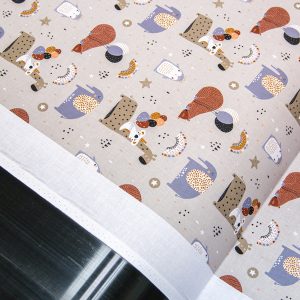Cotton is one of the most widely used natural fibers, and its sustainable alternatives have gained significant attention in recent years. Two of the most popular eco-friendly cotton options are organic cotton and recycled cotton. Each of these materials offers unique advantages, making them suitable for different applications, including textile printing. Understanding the differences between organic and recycled cotton can help businesses and consumers make informed choices about sustainable cotton fabrics.
Table of Content
- What Is Recycled Cotton?
- What Is Organic Cotton?
- Key Differences Between Recycled and Organic Cotton
- Environmental Benefits of Sustainable Cotton
- Certifications for Sustainable Cotton
- Applications and Products Using Recycled and Organic Cotton
- Comparing Recycled and Organic Cotton: Which Is Better?
- The Future of Sustainable Cotton
What Is Recycled Cotton?
Recycled cotton is derived from pre-consumer and post-consumer cotton waste, reducing the need for virgin cotton production. This sustainable fabric helps lower environmental impact by minimizing waste and utilizing existing textile resources.
Pre-Consumer and Post-Consumer Waste
Recycled cotton is categorized based on its source:
- Pre-consumer waste: Scraps and fabric offcuts generated during manufacturing.
- Post-consumer waste: Used textiles, such as old garments and household items, that are processed and repurposed.
By repurposing cotton waste, the recycled cotton production process reduces landfill accumulation and supports a circular economy.
Benefits of Recycled Cotton in Printing
Recycled cotton offers several advantages for textile printing, including:
- Lower environmental impact: Recycled fabric reduces water and energy consumption compared to virgin cotton.
- Unique texture and aesthetic: It can provide a distinctive look and feel, making it appealing for fashion and interior textiles.
- Contribution to waste reduction: Recycled cotton supports sustainability efforts by decreasing textile waste.
What Is Organic Cotton?
Organic cotton is cultivated using natural farming techniques, free from synthetic pesticides and fertilizers. Certified organic cotton is grown under strict guidelines to ensure environmental and ethical responsibility.
Farming Techniques in Organic Cotton Production
Organic cotton cultivation involves sustainable practices such as:
- Crop rotation and composting to maintain soil fertility.
- Natural pest control methods, avoiding harmful chemicals.
- Water conservation strategies, such as rain-fed irrigation.
These techniques ensure that organic cotton farming remains an environmentally friendly alternative to conventional cotton.

Why Organic Cotton Is Popular in Printing
Organic cotton is widely chosen for textile printing due to its high-quality fibers and environmental benefits. Key reasons for its popularity include:
- Better ink absorption: Organic cotton provides a smooth surface for printing.
- Soft and durable texture: Suitable for clothing, home textiles, and accessories.
- Eco-conscious branding: Many businesses prefer choosing organic cotton to align with sustainability goals.
Key Differences Between Recycled and Organic Cotton
While both materials are sustainable, they differ in terms of environmental impact, production processes, and durability.
Environmental Impact
Organic cotton contributes to sustainability by promoting chemical-free farming, while choosing recycled cotton helps reduce waste and resource consumption.
Production Processes
The organic cotton production process relies on ethical farming, whereas recycled cotton fabric is created by reprocessing textile waste.
Durability and Applications
- Organic cotton nurtures durability and is ideal for everyday wear.
- Recycled cotton offers a more textured feel and works well for casual wear, home décor, and accessories.
Environmental Benefits of Sustainable Cotton
Both organic and recycled cotton contribute to sustainable cotton materials, each offering specific ecological advantages.
Water Savings in Cotton Production
Recycled cotton minimizes water usage since it does not require irrigation, unlike conventional or organic cotton.
Carbon Emission Reductions
Using green recycled cotton helps lower carbon footprints by reducing energy demands in fabric production.
Reducing Textile Waste Through Recycling
Recycled cotton conserves resources by repurposing fabric waste, preventing excessive landfill accumulation.
Certifications for Sustainable Cotton
To ensure ethical and sustainable production, both recycled and organic cotton have certification standards.
Global Recycled Standard (GRS) for Recycled Cotton
The Global Recycled Standard (GRS) verifies that produces recycled cotton meets environmental and social criteria.
Global Organic Textile Standard (GOTS) for Organic Cotton
The Global Organic Textile Standard (GOTS) certifies organically grown cotton, ensuring it adheres to strict ecological and labor requirements.

Applications and Products Using Recycled and Organic Cotton
Both fabrics are used in various industries, from fashion to home textiles.
Popular Products Made from Recycled Cotton
Recycled cotton supports the production of tote bags, casual clothing, and upholstery fabrics.
Everyday Uses of Organic Cotton
Organic textile applications include baby clothes, bedding, and premium apparel.
Emerging Trends: Recycled Cotton Blends
The textile industry is exploring integrating recycled cotton with other sustainable fibers to create innovative fabrics like recycled cotton produce bags.
Comparing Recycled and Organic Cotton: Which Is Better?
Both recycled and organic cotton offer significant sustainable benefits, but their suitability depends on specific needs, industry requirements, and environmental priorities. While recycled cotton focuses on waste reduction and resource conservation, organic cotton prioritizes chemical-free cultivation and soil health.
Pros and Cons of Recycled Cotton
Pros:
- Utilizing recycled cotton reduces waste by repurposing pre-consumer and post-consumer fabric scraps.
- Requires significantly less water compared to conventional cotton farming, making it an environmentally friendly alternative.
- Lowers overall energy consumption and carbon emissions associated with textile production.
- Reduces dependence on virgin cotton, decreasing the need for extensive farmland and pesticide use.
Cons:
- Recycled cotton fibers may be shorter and weaker, potentially affecting fabric durability and limiting its applications.
- Variations in texture and quality can occur due to the mix of sourced materials, making it less predictable than virgin cotton.
- The recycling process itself can involve energy-intensive procedures, which may offset some environmental benefits if not managed efficiently.
Pros and Cons of Organic Cotton
Pros:
- Choosing sustainable cotton ensures chemical-free farming, eliminating synthetic pesticides and fertilizers that can harm ecosystems.
- Certified organic textiles are soft, breathable, and durable, making them highly suitable for skin-sensitive applications.
- Encourages biodiversity and improves soil health through eco-friendly farming techniques such as crop rotation and natural pest control.
- Supports ethical labor practices and fair trade initiatives, benefiting farmers and local communities.
Cons:
- Requires significant water and land use, especially in regions where water scarcity is a concern.
- Organic farming often leads to lower crop yields compared to conventional methods, making it more expensive to produce.
- The certification process for organic cotton can be costly and time-consuming, which may limit accessibility for small-scale farmers and businesses.
Ultimately, the choice between recycled and organic cotton depends on priorities—whether reducing textile waste or supporting sustainable agriculture is the main focus. A balanced approach, integrating both options where feasible, may offer the most sustainable solution for textile production.
The Future of Sustainable Cotton
Innovation and consumer awareness are shaping the future of sustainable cotton materials. As sustainability becomes a key focus in the textile industry, advancements in both recycled and organic cotton production are paving the way for a more responsible and eco-friendly future.
Innovations in Recycling Cotton
Technological advancements are improving the efficiency of recycled cotton production, making it more widely accessible. New recycling techniques allow for higher-quality fibers, reducing the need for virgin cotton. Improved sorting methods and mechanical and chemical recycling innovations help maintain fiber strength, making recycled cotton a more viable option for various applications. Additionally, collaborations between fashion brands and recycling initiatives are driving investments in closed-loop systems, ensuring that more cotton waste is repurposed rather than discarded.
Expanding Organic Cotton Cultivation
Efforts to expand organic cotton cultivation focus on increasing fair trade and eco-friendly farming. Organizations and brands are working with farmers to promote regenerative agriculture, soil health, and water conservation. Incentive programs and certifications, such as the Global Organic Textile Standard (GOTS), encourage more farmers to transition to organic methods. Governments and non-profit organizations are also supporting initiatives that provide education and financial aid to farmers, making organic cotton a more sustainable and profitable choice. By expanding organic cotton farming, the industry can reduce its environmental impact while ensuring ethical production practices.
Consumer Role in Supporting Sustainable Practices
Consumers can contribute by choosing recycled cotton and embracing organic cotton in their purchasing decisions, helping create a more sustainable textile industry.
By understanding the differences between organic and recycled cotton, businesses and individuals can make informed choices that align with sustainability goals. Whether selecting organic cotton for printing or recycled cotton for printing, both materials contribute to a greener future in textile production.





